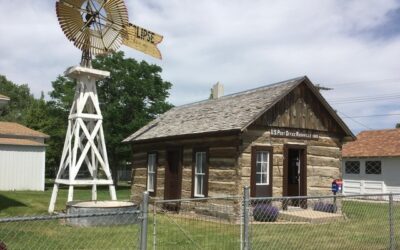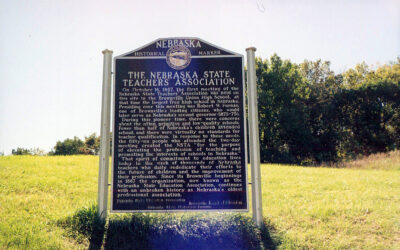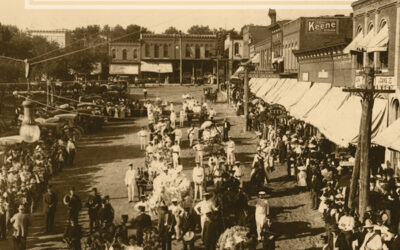HISTORY NEBRASKA MANUSCRIPT FINDING AID
RG2026.AM: LaFlesche Family
Papers: 1859-1939
Nebraska: Omaha Indian Family
Size: 1.5 cu.ft. and 1 reel of microfilm
BIOGRAPHICAL NOTE
The LaFlesche family is descended from Joseph LaFlesche (Iron Eye), last recognized chief of the Omaha Indians, who was born early in the nineteenth century. His seven children belonged to a transitional generation that lived during the years in which the Omaha tribe had to abandon its traditional ways to adapt to the demands of the white man’s culture. The LaFlesches, intelligent and well-educated, fought for the interests of their tribe while they helped its individual members make new lives. The sisters Susette, Susan, and Rosalie and their half-brother, Francis, are particularly noteworthy.
Susette LaFlesche Tibbles, known as “Bright Eyes,” gained an international reputation as a spokeswoman for the American Indian. She and her husband Thomas H. Tibbles publicized the plight of the Indian in their writings and lectures.
Dr. Susan LaFlesche Picotte graduated in 1889 from the Women’s Medical College in Philadelphia, the first Native American woman to become a Doctor of Medicine. She returned to become a physician to the Omahas and campaigned against state and federal agencies for better health care for the Indians.
Rosalie LaFlesche Farley, with her husband Edward, managed the financial affairs of many members of the tribe and served as distributor and accountant of funds sent by Eastern philanthropic organizations.
Francis LaFlesche, an ethnologist with the Smithsonian Institution, wrote and lectured on Omaha customs as well as those of other tribes. He worked on the libretto of Da O Ma, an opera based on Omaha legend, with Nelle Eberhart and composer, Charles Cadman.
Additional information on the LaFlesche family may be found in:
Green, Norma Kidd, Iron Eye’s Family: The Children of Joseph LaFlesche. Lincoln, Neb. 1969.
Wilson, Dorothy Clarke, Bright Eyes: The Story of Susette LaFlesche. New York, 1974.
SCOPE AND CONTENT NOTE
The papers of the LaFlesche family, in three boxes and on one reel of microfilm, are arranged in two subgroups: 1) LaFlesche Family Papers collected by W. Earl Dyer, Jr. 1900-1923; and 2) LaFlesche Family Papers collected by Norma Kidd Green, 1859-1939.
This collection is comprised of papers of various members of the LaFlesche family. The materials in Subgroup 1 were received from W. Earl Dyer, Jr., in 1962, and relate to the writing of Da-O-Ma. The opera was based on an Omaha Indian legend, with the libretto by Francis LaFlesche and Nelle Richmond Eberhart, and the score by Charles W. Cadman. Subgroup 1 is arranged in three series: 1) Correspondence, 1900-1927 and undated; 2) Libretto; and 3) Miscellany, 1923 and Undated.
The correspondence of Series 1 concerns the opera, and is primarily between Charles Cadman and Francis LaFlesche. Letters from Nelle Eberhart are also present. Series 2 contains a copy of the completed libretto with notes and partial preliminary drafts. The Miscellany is comprised of clippings and programs regarding Cadman’s performances of, and lectures on, Indian music. Also included is a copy of the will and related papers of Alice Cunningham Fletcher, an ethnologist who was a friend and associate of Francis LaFlesche.
The material in Subgroup 2 was received from Norma Kidd Green, who used the contents of this entire collection as a source for her book, Iron Eye’s Family. The bulk of this subgroup consists of letters written to Rosalie LaFlesche Farley, and saved by her daughter Marguerite Farley Conn. Correspondents include Susan LaFlesche Picotte, Francis LaFlesche, Alice Cunningham Fletcher, and Sara T. Kinney of the Connecticut Women’s Indian Association. Letters from the Farley sons to their parents are also present. Diaries kept by Rosalie in 1898 and 1899; a diary kept by Susan Picotte; and autograph books of Susette LaFlesche Tibbles and Marguerite LaFlesche Diddock, form the remainder of the subgroup.
Note to Researchers: Series 1 through 11 of Subgroup 2 were arranged for microfilming by Norma Kidd Green. Her original arrangement has been maintained so that this section of the Description can serve as a partial inventory to the film. The original documents in Series 1 through 9, housed in Box 2, are restricted. Researchers must use the microfilm. Using the film is actually an advantage in this case, because Mrs. Green identified many letter fragments and annotated many of the items on the film. Her notes, appearing on the film, have since been lost or separated from the pages to which they referred.
Series 10 [Box 3] contains some genealogical materials on the LaFlesche family is not on the film, and is not restricted. The 1898 diary of Rosalie LaFlesche Farley, in Series Eleven, appears on microfilm only. The original diary is not a part of the collection.
Series 12 through 16 of Subgroup 2, were not filmed.
Note: See the photo component [RG2026.PH] for photographs. Approximately 82 photographs [formerly PC0824] show members and homes of the LaFlesche Family.
INVENTORY
Subgroup 1: LaFlesche Family papers from W. Earl Dyer, Jr., 1900-1923
Series 1 – Correspondence, 1900-1927, n.d.
Box 1
Folder
- 1900-1927
- Undated
Series 2 – Libretto
Box 1
Folder
- Libretto and notes for Da-O-Ma
Series 3 – Miscellany, 1923 and n.d.
Box 1
Folder
- Clippings regarding Charles W. Cadman
- Clippings regarding Charles W. Cadman
- Programs relating to Cadman’s interpretation of Indian music
- Will and related papers of Alice Cunningham Fletcher; In Memoriam, 1923 film
- Music by Cadman and Eberhart
- Miscellaneous Cadman materials
Subgroup 2: LaFlesche Family papers from Norma Kidd Green, 1859-1939
Series 1 – Correspondence of the LaFlesche Family, 1885-1923
Reel 1
Box 2
Folder
- Information about the acquisition of the papers on microfilm
- Susan LaFlesche Picotte to her sisters, 1885-1888
- Francis LaFlesche, mostly to Rosalie LaFlesche Farley, 1886-1923
- Miscellaneous correspondence, 1887-1923
Series 2 – Diary of Rosalie LaFlesche Farley, 1899
- Diary, 1899, Aug.-Dec.
Series 3 – Correspondence of Alice Cunningham Fletcher, 1886-1921
- Alice Fletcher to Rosalie Farley, 1886-1921
Series 4 – Correspondence of the Farley sons, 1889-1917
- Correspondence between Ed and Rosalie Farley and their four sons, 1889-1917
Series 5 – Financial papers, 1859-1900
- Notes, bills, receipts, 1859-1900
Series 6 – Printed matter, 1912-1939
- Clippings, 1912-1939
Series 7 – Correspondence relating to the estate of Peter Sarpy, 1888
- Correspondence regarding funds due Ne-co-mi from the estate of Peter Sarpy
Series 8 – Correspondence regarding the Connecticut Indian Association, 1886-1898
- Correspondence with individuals involved in the Connecticut Indian Association, 1886-1898, mostly from Sara T. Kinney
Series 9 – Correspondence of Rosalie LaFlesche, 1887-1899
- Rosalie LaFlesche to Francis LaFlesche, 1887-1899
Series 10 – Genealogy
Reel 1
Box 3
Folder
- Genealogical information about the LaFlesche family. [Note: Some material in this folder is not on the microfilm]
- Oversize genealogy chart [original by Norma Kidd Green, and copy] (see oversize)
Series 11 – Diary of Rosalie LaFlesche Farley, 1898
Reel 1
Diary of Rosalie LaFlesche Farley, January-December 1898 [Note: This diary is on microfilm only. The original is not in the collection.]
Series 12 – Papers of Susan LaFlesche Picotte, 1907-1917
Box 3
Folder
- Correspondence, 1914-1917
Report of the Chairman of the State Health Committee, 1914
Testimony at the investigation of the death of Henry Warner, 1914 - Diary, 1910, Sept. – 1911, Jan. [photocopy, original restricted for preservation]
- “Folklore Tales of the American Indians”
“Primitive Farming among the Omaha Indians” (published in the Sunday World Herald, Omaha, Neb., Feb. 25, 1912) - Clippings
Series 13 – Papers of Marguerite LaFlesche Diddock, 1880-1930
Box 3
Folder
- Correspondence, 1907-1930
- Autograph book, 1880
- Miscellany
- Diploma from Hampton Institute, 1887 (see oversize)
Series 14 – Papers of Susette LaFlesche Tibbles, 1880-1896
Box 3
Folder
- Autograph book, 1880-1896 [Copy only. The original is not in the NSHS collection.]
- “Bright Eyes, Data for a Sketch, 1902” by Addison E. Sheldon
Nebraska Hall of Fame materials, 1984
Series 15 – Clippings, n.d.
Box 3
Folder
- Clippings on various members of the LaFlesche family, undated
Series 16 – Miscellany, 1859-1897
Box 3
Folder
- Record of annuity payments to the Omaha Indians, 1859, 1871
- Account book, 1896-1897 (probably kept by Rosalie or Ed Farley)
- Typescript relating to the Treaty with the Omaha, March 16, 1854
Letter from Joseph LaFlesche, 1859
Typescript article relating to Joseph LaFlesche [two copies] Sketch [portrait of Louis LaFlesche?]; etc. - “Wa-Ja-Pa’s Letter”
- “The Twin Brothers Adventures,” by Francis LaFlesche
An illustration from The Middle Five, by Francis LaFlesche - Map of the Omaha Indian Reservation, 1862 (see oversize)
- Miscellany
Subject headings:
Bright Eyes – SEE – Tibbles, Susette LaFlesche, 1854-1903
Iron Eye – SEE – LaFlesche, Joseph, 1822-1889
Cadman, Charles Wakefield, 1881-1946
Connecticut Indian Association
Diddock, Marguerite LaFlesche, 1862-1945
Eberhart, Nelle Richmond
Farley, Rosalie LaFlesche, 1861-1900
Farley Family
Fletcher, Alice Cunningham, 1845-1923
Gale, Mary, 1826-1909
Hampton Institute (Hampton, Va.)
Kinney, Sara Thompson
LaFlesche Family
LaFlesche, Francis, 1857-1932
LaFlesche, Joseph, 1822-1889
Ne-co-mi
Picotte, Susan LaFlesche, 1865-1915
Sarpy, Peter Abadie, 1805-1865
Tibbles, Susette LaFlesche, 1854-1903
Tibbles, Thomas Henry, 1838-1928
Diaries
Indians of North America
Indians of North America — Folkore
Indians of North America — Music
Indian women — Nebraska
Omaha Indians
Omaha Indians — Maps
Omaha Indians — Social life and customs
Opera
Operas — Librettos
Physicians — Nebraska
Women physicians — Nebraska — Thurson County
Women in public life — Nebraska
07-23-2007 Revised TMM/tmm




